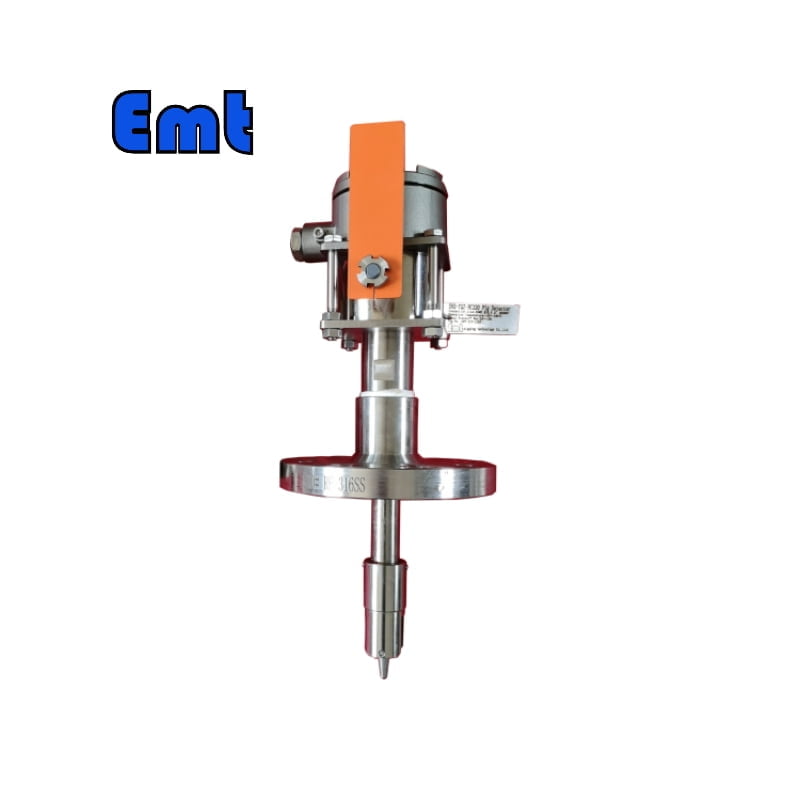Description
Description:
The intrusive pig signaler is mechanically operated. And pig signalers are generally bi-directional. They have mechanically operated signal flags. The flag can be reset manually. Besides, the flags are suitable for mounting on both vertical and horizontal pipelines. The indicating device, flag, is normally set in the horizontal position for “pig not passed” and vertical for the “pig passed” condition with a manual latch reset to the horizontal position. When a pig is moving through production pipework and pipelines the time or location of the pig is known. In addition, it can estimate accumulated debris in front of the pig which can help you identify which section of pipe debris is being built up.
General Function:
A Pig Signaler is a machine that is mounted on the pig transmitter and receiver stations. Its function is to confirm the launch or arrival of the cleaning pig. They are installed on the pipeline and detect the passage of all types of pipeline pigs. The flag is interactive with the trigger mechanism, so the flexibility of the trigger mechanism can be checked online. When pigs clean the pipe, the pig indicator is used to detect whether the pig is passed or not. It is easy to install through the flange. The flange can be made in different sizes to meet the requirements of all kinds of pipes.
Application:
This product is used for checking the passage of cleaning pigs in oil, gas, water, and other kinds of pipelines.
Pig Signaler with Manual Reset Flag (Flange connection)

- Connection type: Flange connection
- Types of pig signaller: Intrusive, Manual reset flag
Basic Features or Parameters:
- Installing type: 2” Flange As per ASME B16.5(CLASS150-2500)
- Plug body length: 20mm/Meet customer requirement
- Insert depth(In pipe): 21mm
- Insert depth adjustment: Unadjustable
- Operating temperature: -20℃~120℃/Meet customer need
- NACE MR 0175: Yes
- Ingress Protection: IP66
- Remove under pressure: No
- Trigger type: Bi-directional/Uni-directional
- Internal part material: 316LSS
- Flange/Body material: PTFE Coated A105N/Meet customer need
- The standard configuration of Uni-directional trigger shape: Ball shape
- The standard configuration of Bi-directional trigger shape: Firing pin shape
Drive Mode:
Direct drive(Bi-directional trigger)
Magnetic(Uni-directional trigger)
The mode of direct drive has a better performance. Besides, it is maintenance-free. The mode of magnetic can be checked online. The force of the trigger is not affected by the pressure in the pipes. So the trigger is more sensitive under the same pressure. In other words, this product with magnetic drive mode can be more easily triggered than this product with direct drive. However, after a long time of use, the uni-directional indicator’s trigger may be blocked by grease or some impurities in the pipe. So it needs to be cleaned up and maintained. Compared with the trigger of a uni-directional Pig Signaler, a Bi-directional trigger is less likely to get caught in grease. So, the uni-directional trigger is not needed to maintain.
How does it work?
This product is triggered when the pig passes through the pipe. It contains a flag and a set of trigger devices. The flag is set in the horizontal position to indicate that the pig has not passed. When the pig passes through, the firing pin is moved to pull the connecting rod in the seal sleeve, indicating that the flag shaft rotates 90° under the action of the torsion spring, from the horizontal state to the upright state. It indicates that the pig has passed. The passage of the cleaning pig can be known by the position of the flag.
What is the Difference Between Intrusive and Non-intrusive Pig Signallers?
An intrusive pig signaller is a machine inserted into a pipe. While a non-intrusive Pig Signaler is a machine used outside the pipe. In most cases, intrusive pigs are mechanically attached to the pipes. However, this needs a 2-inch branch connection or an opening on the pipe. Sometimes, when the condition of a 2-inch branch connection is not met, or the opening is inaccessible, a non-intrusive Pig Signaler is used. Non-intrusive Pig Signalers can be set anywhere in the pipes. The installation is easier than intrusive Pig Signalers.
Flange Connection:
The flange connection is a common type of pipe connection. It can ensure the stability and sealing of pipeline connections. The flange connection process mainly includes the following steps:
- Preparation: Select the appropriate flange and seal, check whether the surface of the flange is smooth, and clean the debris and grease on the surface of the flange and pipe end face.
- Install the flange: Align the flange with the end face of the pipe and fix the flange to the pipe with bolts. Pay attention to the tightening sequence and strength of the bolts to avoid leakage
- Install the gasket: Place the gasket between the flanges and ensure that the size and shape of the gasket match the flange to avoid distortion or displacement during fastening.
- Fastening flanges: Use a wrench or torque wrench to tighten bolts one by one, in a certain sequence and with a certain amount of force, until all bolts are fastened in place.
- Check: Check whether there is water leakage or leakage in the connection. If there is water leakage or leakage, remove the flange and replace the sealing gasket, and then tighten the flange again.
It should be noted that when installing flange connections, appropriate flanges and sealing gaskets should be selected according to the material, pressure, temperature, and other factors of the pipeline to ensure the safety and reliability of the connection.
CONTACT US
If you need this product then contact us. We will always provide our best and most professional advice for you.
Besides this product with a manual reset flag by flange connection, we also provide pig signalers that can be welded connected. For example, a Pig Signaler with a manual reset flag combined with an electrical switch output; a pig signaller with a digital display combined with an electrical switch output.
We provide removable pig signalers too. For example removable pig signaller on flange valve, removable Pig Signaler with ball valve, and removable pig signaller with an isolation valve.
(Pig Signaler)







Reviews
There are no reviews yet.